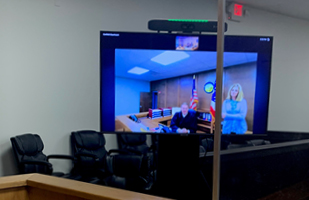Remote Technology Central in Proposed Court Rule Changes

The Supreme Court is modernizing several court rules that highlight the use of remote technology in every day operations.

The Supreme Court is modernizing several court rules that highlight the use of remote technology in every day operations.
A series of proposed rule changes to the practices and procedures in Ohio’s courts have been filed with the General Assembly. Among the amendments are proposals for the use of remote technology to make courts more accessible and efficient.
The amendments were submitted by the Supreme Court of Ohio’s Commission on the Rules of Practice and Procedure and incorporate two rounds of public comment. The commission conducts an annual review of the state’s Rules of Civil Procedure, Rules of Criminal Procedure, Rules of Appellate Procedure, Rules of Juvenile Procedure, Rules of Evidence, and Traffic Rules. Each fall, the commission recommends amendments to the Supreme Court. The proposals are published twice for public comment, in fall and winter.The amendments allow testimony and arraignments in criminal cases to be held remotely. A criminal defendant also can appear remotely during substantive court proceedings – arraignment, trial, or sentencing – if they waive their right to be present in the courtroom. Given a defendant’s right to confront witnesses under the Sixth Amendment of the U.S. Constitution, a new staff note to Criminal Rule 43 encourages judges to consider that right when deciding whether to allow remote testimony during a criminal matter. In all matters – criminal, civil, and juvenile – the rule changes still allow a judge the option to order a party, attorney, or witness to physically appear in court.
For civil cases, the amendments to Civil Rule 39 allow parties to request a trial to be conducted remotely. However, unless all parties agree, a civil jury trial cannot be conducted without the jury physically present in the courtroom. Finally, the court retains discretion to determine whether the trial will be conducted remotely. Civil Rules 5 and 11 further expand accessibility to the justice system for all Ohioans by requiring courts to accept electronic filings and signatures.
Among the criminal rule amendments is the ability for courts to allow, by local rule, the creation and filing of electronic criminal complaints and summonses.
Following a Supreme Court decision that raised concerns regarding double jeopardy, Criminal Rule 33 removes the option to grant a new trial if evidence in a case is not sufficient to sustain a conviction. Instead, insufficient evidence can serve as the basis for a motion for acquittal under Criminal Rule 29.
With the General Assembly recently placing the burden of proof on the state to disprove self-defense claims, Criminal Rule 12.2 regulates when that argument needs to be presented to a court. To allow prosecutors sufficient time, such claims must be presented 14 days before trial for misdemeanors and 30 days for felonies. The rule already in place for notice of alibi – Criminal Rule 12.1 – is revised to include the same timeframe.
Among the proposed amendments to the Traffic Rules is the ability to enter a not guilty plea for an offense electronically.
Updates have also been made in civil rules for low-income Ohioans seeking to waive prepayment costs and fees. Civil Rule Form 20 was adjusted to show the revised federal poverty limits for individuals and families. This change has already gone into effect. The others, unless rejected by the General Assembly, take effect July 1.
The Ohio Constitution mandates submission of amendments to court practice and procedure rules to the General Assembly by Jan. 15 each year, and the Supreme Court has until April 30 to make revisions and file amendments. Unless the General Assembly adopts a concurrent resolution of disapproval before July 1, the amendments become effective on that date.
.


